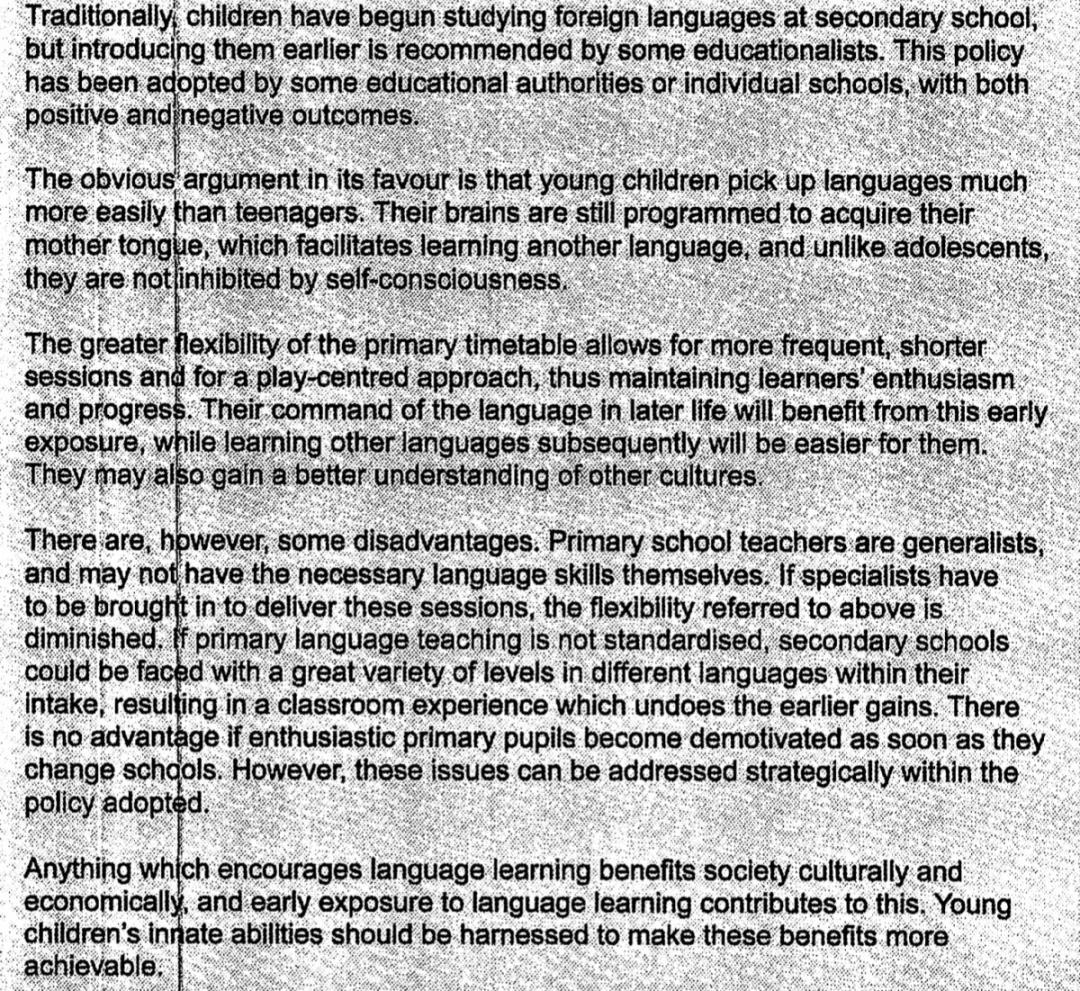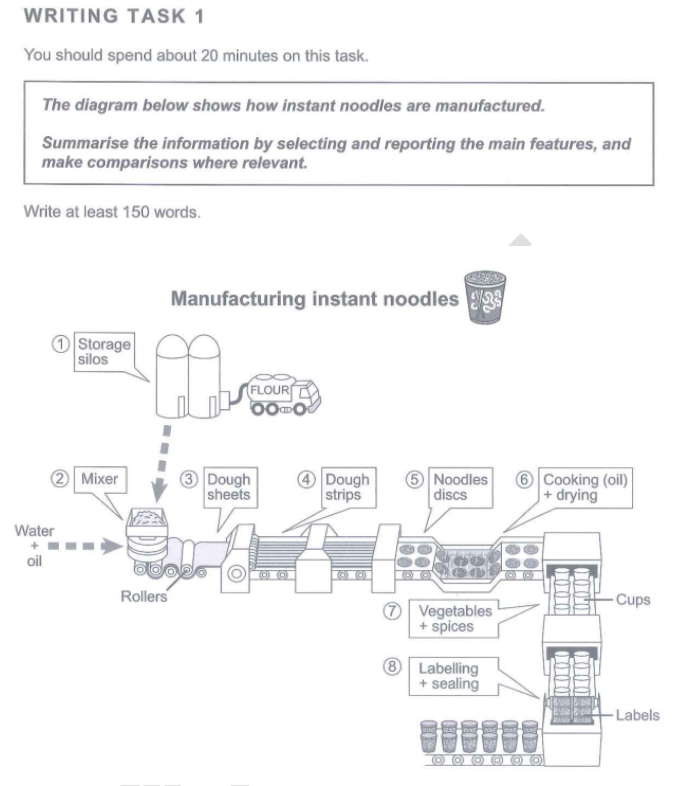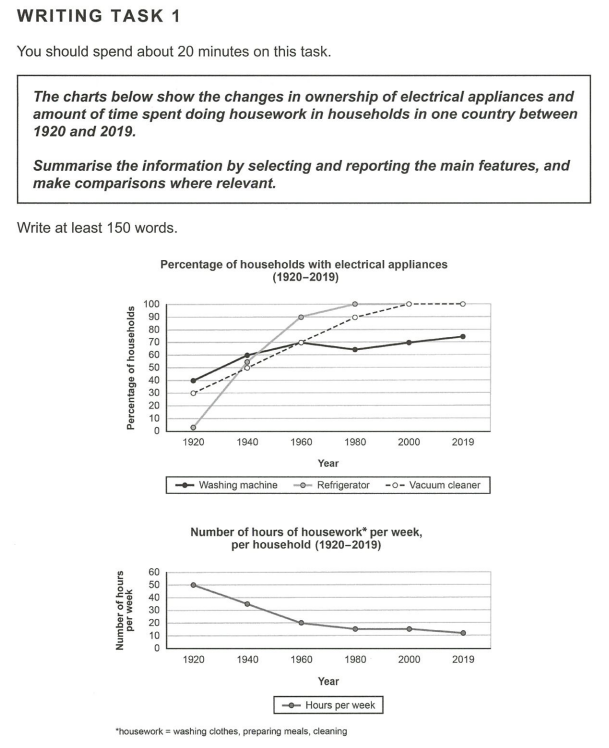雅思写作怎么提高到6分?教你写一篇好文章
雅思写作怎么提高到6分?教你写一篇好文章 雅思写作怎么提高到6分?雅思写作怎么才能得7分?雅思写作怎么快速提高?这都是大家经常问到的问题!那么本文陈颖老师告诉大家什么样的文章才是一篇雅思的好文章,帮助学生消除一些雅思写作的错误认知。
针对人群
需要提升写作尤其是雅思考试需求的学生
本篇重点:结合写作评分标准细则对剑桥考官展示范文进行详细解析
分享嘉宾

分享概要
▶ 陈颖老师告诉大家什么样的文章才是一篇雅思的好文章,帮助学生消除一些雅思写作的错误认知。
小贴士
今天的文章可能会有一丢丢晦涩,各位备考雅思托福的小伙伴要仔细研读哦~
C9 T1
Some experts believe that it is better for children to begin learning a foreign language at primary school rather than secondary school. Do the advantages of this outweigh the disadvantages?
准备工作
审题
1. 问题是什么?
题干首先描述了背景,有的专家认为孩子应该从小学而非中学就开始学习外语,而真正的问题是,让孩子在小学(而非中学)就开始接受外语教育的优点是否大于缺点?实际是需要你去分析这样做的优缺点,然后将其进行比较。
2. 对象和范围
题干中描述的很清楚,对象即为children, 而讨论的范围则是针对learning a foreign language in primary school 和learning a foreign language in secondary school.
需要将这两个的优缺点进行对比。
3. 题型
这道题属于观点类的题型,需要你给出优缺点,并进行比较。
4.列观点
小学就开始进行外语教育 - 学习的时间更充裕 - 更好地掌握外语,打好基础
中学开始进行外语教育 - 受母语思维的影响 - 学习效果不好
5. 组织语言

2
标准——Task Response
Task Response
1. all parts of the topic are responded to well
段1:children对应题干children;
begun learning foreign languages对应题干begin learning a foreign language;
at secondary school, introduce them earlier, educational authorities or individual schools对应题干primary school和secondary school;
some educationalists对应题干some experts;
both positive and negative outcomes对应题干advantages 和disadvantages。
段2: young children对应children (at primary school);
adolescents 对应children ( at secondary school);
pick up languages, learning another language对应learning a foreign language。
段3: the primary timetable 对应at primary school;
learning other languages对应learning a foreign language。
段4:disadvantages对应disadvantages;
primary school teachers对应at primary school;
primary language teaching对应learning a foreign language at primary school;
secondary schools对应secondary school。
段5:language learning对应learning a foreign language;
earlier exposure to language learning 对应learning a foreign language at primary school;
young children对应children。
2. all parts of the question are responded to well
题干的问题是让孩子在小学就开始接受外语教育的优点是不是多余缺点?即需要分别举出优点和缺点,同时将其进行对比。
段2:The obvious argument in its favor is that...;
段3:The greater flexibility...分别是对这样做之后多产生的积极影响,即优点的论述。
段4:There are,however, some advantages.是对其缺点,不足的论述。
句13提出这些缺点是可以克服的,表明自己的观点认为优点大于缺点。
同时在段4对缺点的论述中对照之前对优点的论述,进行对比,例如:..., the flexibility referred above is diminished.
段5: 表明自己的观点支持从小接触外语学习,一定程度上回答了问题,认为优点多于缺点。
所以,范文对问题的各个部分都做出了回应。
3. main ideas are clear
文章的主体段应该是段2,3,4.我们分别找他们的main idea.
段2:main idea 应该是句3 The obvious argument in its favor...支持孩子从小学就开始学习外语的一个观点就是儿童比青少年更容易习得语言。
段3:main idea 是句5,The greater flexibility...小学时间安排的灵活性可以提供孩子更多的时间接触外语,从而确保他们对语言学习的热情以及多能取得的进步。
段4:main idea是句8,点出有多个disadvantages。
4. explanation/examples of main ideas are clear
我们依然分析主体段。
段2的逻辑:句3 main idea,提出儿童比青少年更容易习得语言。句4则是对句3的解释,因为在那个阶段,儿童还在学习母语,可以促进他们对外语的接收学习。
段3的逻辑:句5 main idea,提出小学的时间安排更加宽裕,让孩子取得进步,同时保持学习的热情。句6,7 补充说明早期的外语学习促进他们日后的语言学习和发展,同时加深他们对其他文化的了解。
段4的逻辑:句8 首先转折开始讨论disadvantages. 句9提出不足可能在于小学老师可能不具备专业的语言教学能力。句10 照应段3,引入专家即对段3 的flexibility这一优点进行否定,句9问题难以用此方法解决。
句11,12 则是对将会产生的后果的阐述。句13 However, 在此转折,提出这些可能的问题都是可以被解决的,一定程度上表明作者的观点,认为优点大于缺点。
3
Cohesion and Coherence
1. good overall structure
范文的逻辑是十分清晰的。
段1:描述背景,表明在小学就开始接受外语学习的话既有优点又有缺点。
段2,3 :对这样做优点的陈述,涉及了支持孩子从小学就开始学习外语的客观原因以及会产生的结果两个方面。
段4:句8 however转折,从段2,3 对优点的描述过渡到对缺点的描述。论述过程照应段3,句13又提出这些缺点是可以解决的,表明了作者认为优点大于缺点的态度。
段5:进行总结。直接表明观点早期学习外语更有利于对语言以及文化的掌握。
2. the first paragraph clearly introduces the essay
句1是照应题干背景的描述,句2提出这样做既有优点又有缺点,引出下文对优点和缺点的描述。
3. topic sentences introduce paragraphs well
对主体段进行分析。
段2:句3即为main idea, 提出了孩子在儿童阶段更加容易学习语言。陈述了支持孩子从小学就开始学习外语的一个客观原因。
段3:句5同为main idea,对假如这样做之后,产生的积极影响来陈述它的优点。
段4:句8为main idea,开始转而论述disadvantages。
4. clear central topic within each paragraph
这一点与之前的main idea相似。
段2:The obvious argument in its favor...支持孩子从小学就开始学习外语的一个观点就是儿童比青少年更容易习得语言。从客观原因上分析了孩子从小开始学习外语的好处。
段3:The greater flexibility...小学时间安排的灵活性可以提供孩子更多的时间接触外语,从而确保他们对语言学习的热情以及多能取得的进步。可能产生的积极影响上面论述这样做的优点。
段4:Primary school teachers...小学老师往往注重了解多方面的知识,所以可能缺乏专业的语言教学能力。从小学老师的能力方面分析缺点。
5. logical paragraph development
段1:背景描述,引出话题。
段2,3:对让孩子从小学开始学习外语的优点的描述。
段4: 陈述缺点。句8转折,从段2,3 讨论优点转而讨论缺点。句13,表明自己的态度,认为这些缺点是可以解决的,所以优点多于缺点。
段5:总结,再次表明自己的观点。
6. linking phrases are used well
段1:Traditionally, (副词做状语)
children have begun studying foreign languages at secondary school, (照应题干,children,learning a foreign language, secondary school)
but introducing them earlier is recommended by some educationalists.(but 转折,them指代foreign languages,earlier照应题干primary school, educationalists照应experts)
This policy(指代introducing them earlier)
..., with both positive and negative outcomes.(照应advantages, disadvantages,引出对优缺点的论述)
段2:The obvious argument in its favor( its 指代begin learning a foreign language at primary school)
is that young children(指代children at primary school)
...than teenagers(指代children at secondary school).
Their brains are...(Their 指代young children)
, which facilitates learning another language,(照应learning a foreign language)
and unlike adolescents, (照应teenagers)
they are not ...(they 指代young children)
段3:...of the primary timetable(照应 at primary school)
..., thus maintaining...(thus表述因果)
Their command of the language...(Their指代前面learners)
from this early exposure,(early exposure指代learning a foreign language at primary school)
while learning...(while表示与此同时)
They may also...(They 指代learners,also表示补充,也)
段4:There are, however, some disadvantages.( There be句型,however转折)
Primary school teachers...(照应primary school)
If specialists(对照experts)
have..., the flexibility referred to above...(照应段3,对其进行否定)
If primary language teaching is ...(照应learning a foreign language at primary school)
, secondary schools could be ...(照应secondary school)(虚拟语气)
There is no advantage(There be 句型,照应advantages)
if enthusiastic primary pupils...(照应段3 maintaining learners’ enthusiasm, primary pupils 照应children at primary school)
However, (转折)
these issues(照应句9-12)
can be addresses strategically within the policy(指代让孩子从小学开始学习外语)
adopted.(表明观点,认为优点大于缺点)
段5:Anything which (定语从句)
encourages language learning(照应learning a foreign language)
..., and early exposure(照应之前exposure,指代learning a foreign language at primary school)
to language learning contributes to this. (this 指代benefits society culturally and economically)
Young children’s ...make these benefits more achievable.(benefits 照应benefits society culturally and economically)
4
Lexical Resources
1. appropriate word choices
这一项标准主要包括两个方面:一方面是搭配是否地道,即collocation(词伙)的使用是否正确。
这就要求我们在学习单词时以词伙为单位进行记忆,多关注搭配,而不是简单地背单词。
另一方面是语义、语域是否恰当。语域可分为中性、正式、非正式,又可分成口语和书面语。
雅思写作中要求的是中性或正式的书面语。我们可以看到范文中是没有非正式或口语化的表达出现的。
2. control of word endings/forms
这一点一方面是指不同词性的熟练转换和应用。
另一方面,名词的单复数结尾、动词的各种形式,也在该标准的考量范围之内。
例如:benefit (n/v)--benefits society & make these benefits more achievable;enthusiasm- enthusiastic。
3. repetition is avoided
这条标准是我们耳熟能详的:替换词的使用。
我们举一些范文中的替换表达:
Children: young children, teenagers, adolescents, learners, primary pupils
Learning a foreign language: studying languages, pick up languages, learning another language, learning other languages, language learning
Learning a foreign language at primary school: early exposure to language learning, primary language teaching
Benefits society culturally and economically: these benefits
Advantages, disadvantages: positive and negative outcomes, the obvious argument in its favor
4. spelling is correct
无须多言,除了平时练习后可找同学/老师批改外,也可以把文本输入电脑检查。
5
Grammatical Range and Accuracy
1. a variety of sentence structures are used
关于语法的两大标准中,grammatical range是比较难把握的,也很难用一两句话说清楚。
我们只有通过不断地分析范文来揣摩。在第一篇的分析中,我们只作简单句/并列句和复杂句的区分。
【开头段】
句1:并列句
句2:简单句
【主体段1】
句3:复杂句
句4:并列句套复杂句
【主体段2】
句5:复杂句
句6:复杂句
句7:简单句
【主体段3】
句8:简单句
句9:并列句
句10:复杂句
句11:复杂句
句12:复杂句
句13:简单句
【总阶段】
句14:并列句套复杂句
句15: 简单句
可以看出,全篇复杂句和简单句交替使用。范文多使用复杂句,但是主体段2,3 使用简单句结尾,主体段3用简单句进行转折,简洁明了,承接自然。
2. Articles
冠词的正确使用。看上去很细节,其实很重要。
3. sentence structures are correct
句法的正确性在语法评分中占比很高,如果有两句以上句法出错,语法分很容易降到5.5以下。所以请大家优先确保句法正确,再去追求句式的复杂性和多样性。
4. punctuation is correct
雅思作文中通常不出现疑问句和感叹句,所以最常用的标点就是逗号和句号,分号和引号偶尔使用。
通常句号的使用不会有问题,但逗号的用法就有比较多的讲究,需要在学习语法和积累词伙用法时多注意。







